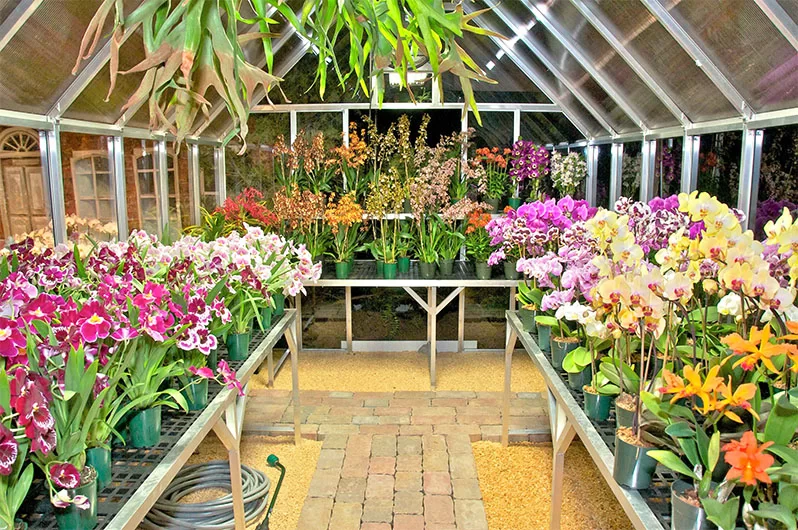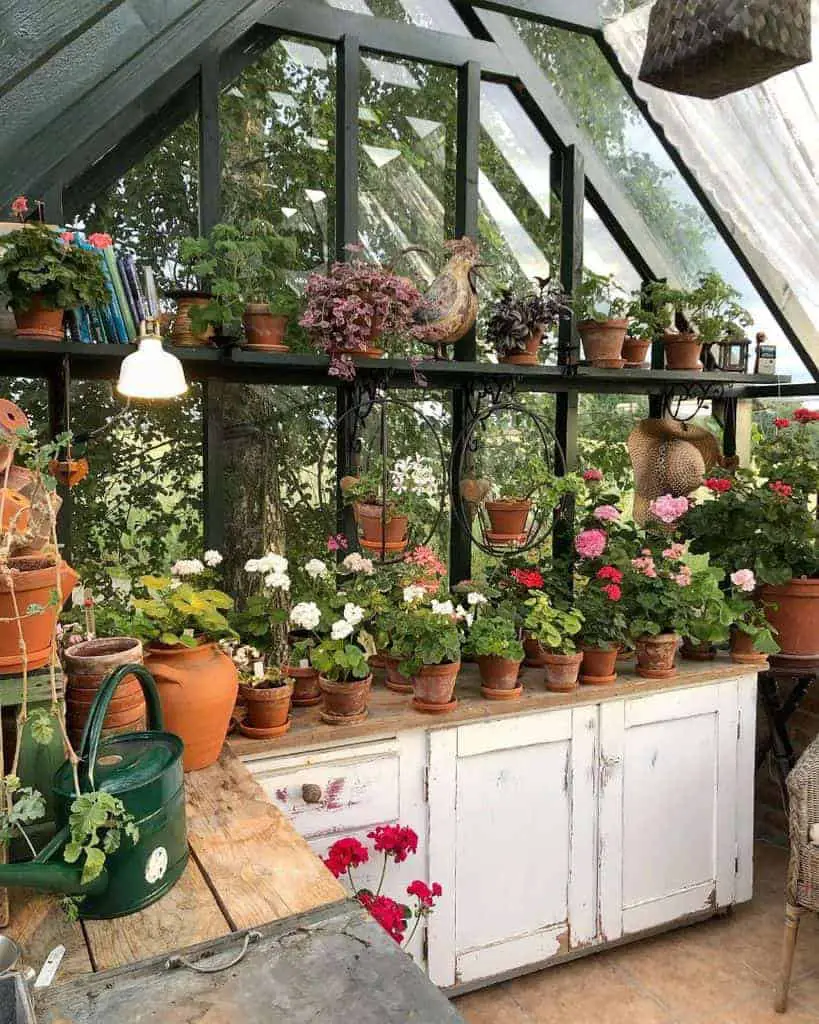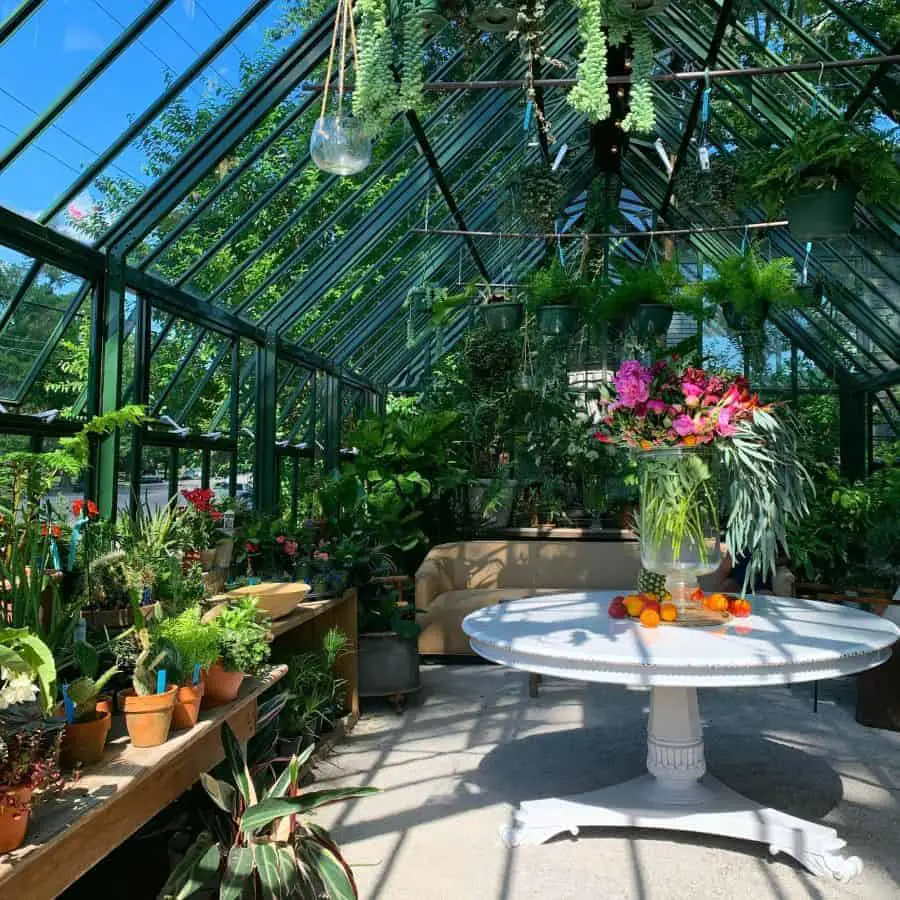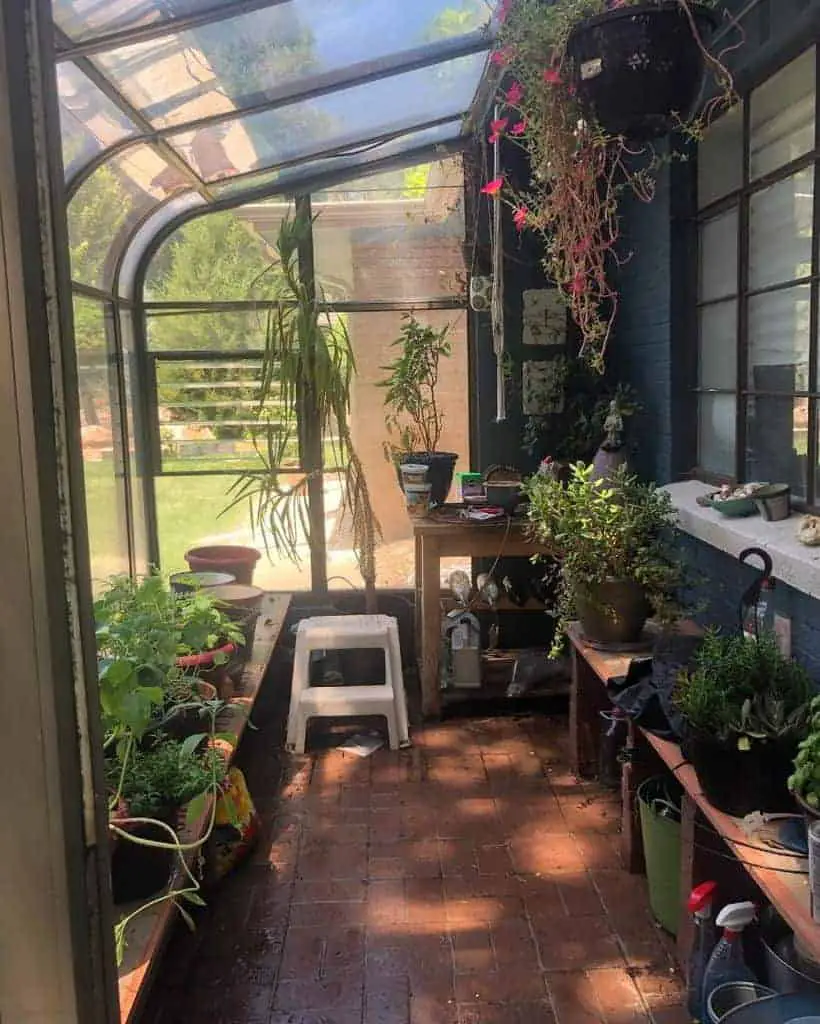How do you build a greenhouse that’s perfect for orchids? Oh, I wish I had a simple 6 step answer to that question. I’m in the middle of planning out my greenhouse and the the more I researched, the more questions I had. I figured that if I had questions, you may have the same ones. That is why I am writing this post, but it’s specifically about the layout of the orchid greenhouse. I will cover other topics about greenhouses in other posts too.
The layout of a greenhouse are crucial for the successful growth of your orchids. In this article, I’ll discuss the necessary structures (layout) to add to your greenhouse to optimize your work (and pleasure) with orchids. I’ll also touch on different styles of greenhouses and help you by providing inspiration for your own setup.
Why Greenhouses Are Necessary For Orchids
Before I get into the specifics of what to look for in a greenhouse for orchids, I want to just go over a few things that are overall important when thinking about a greenhouse. Orchids are delicate plants that require specific conditions to thrive. Greenhouses are necessary for orchids because they provide a controlled environment, protect against harsh weather, prevent pests and diseases, and offer a dedicated space for orchid care. By having an enclosed greenhouse, you can create the ideal conditions for your beloved plants to thrive and flourish.
1) A greenhouse provides a controlled environment for orchids. Temperature, humidity, and light levels can be regulated to mimic their natural habitat. This ensures that orchids receive the optimal conditions for growth and blooming no matter what the season. For example, some orchid species require cooler temperatures at night to trigger flowering, which can be easily achieved in a greenhouse.
2) A greenhouse protects orchids from harsh weather conditions. Extreme temperatures, strong winds, and heavy rains can damage or even kill orchids. By placing them in a greenhouse, orchids are shielded from these external elements, allowing them to grow and bloom without the risk of damage.
3) Greenhouse offers protection against pests and diseases. Orchids are susceptible to various pests and diseases that can quickly spread and devastate a collection. In a greenhouse, proper ventilation and screening can prevent pests from entering, reducing the risk of infestations. Additionally, the controlled environment helps to minimize the occurrence of fungal or bacterial infections.
4) Greenhouse provides a dedicated space for orchid care and cultivation, but also for my relaxation. With hanging shelves, plant racks, and potting tables, it becomes easier to organize and maintain a collection of orchids. The greenhouse also serves as a sanctuary for us, orchid enthusiasts, allowing ourselves to immerse in the beauty and tranquility of these exquisite plants. That’s why I want a little additional space to add a reading chair or a small side table with chairs (maybe a bench?) to really enjoy the space.
These four items need to be in your mind at all times when designing your greenhouse.
External Structure of a Greenhouse
No space is too large, so mack your defining limit of how big you can go mainly on your budget. Start by calculating at least 14ft (4.2 m) wide by at least the same length for your orchid greenhouse, so 14′ x 14′ would be ideal. It might be better to expand that to 20ft (6m) if you have the space. You might be thinking that is a lot or way too big, but believe me, it isn’t.
Orchids have some kind of crazy spell that they cast on us, where we just can seem to have enough. What once started out as a gift (probably) or a random pick-up item in a grocery store, slowly started to take over your window sill. Then a plant ledge wasn’t enough. In my opinion, if you are going to invest in greenhouse, then might as well build one that will house the entire collection (at least for the time being).

Photo Credit: ClimaPod
Here are a few tips to consider when building the external structure:
- Home Owners Associations. I’m not a big fan of HoAs, myself. I lived in one for 4 years and it was ok, but man, did they hate change. If trying to approve building a greenhouse on your property is overruled, then you can try a pergola. Since those are readily approved and easier to gain those sympathetic smiles, get a pergola approved. Then throw a shade cloth over it. No need to mention the shade cloth at the time of building.
- Local Housing and Property Rules. Depending on the Housing and Property Rules, having a greenhouse built, may need a permit. In some places, if the greenhouse is over a certain square footage, a permit is required. In my rural area, they were fine with whatever I built as long as it was a certain distance (20m) from the main road.
- Your Spouse. Please consider your spouse when starting to build things that will take a considerable amount of time and money. This could be a great project to work on together and their input is very valuable, since they are giving up their plot of grass too. Construction is usually one of those things that couples fight about often, so just saying…
- Your Family Pets. Max (my dog) created havoc with my orchids and I found out that I had to find a type of greenhouse that would keep him out for good. At first I was considering a lath house (you can read that article here) but that wouldn’t work with Max. If you are in an area that have deer, rabbits, possums, squirrels or any other little critter, then it might be a good idea to make an external structure that deters those animals. Pick your most common enemy and fool proof the greenhouse against it.
Internal Structure of a Greenhouse
The internal structure of a greenhouse is essential for creating the ideal environment for orchids to thrive. Each component of the greenhouse serves a specific purpose in ensuring the optimal growth and care of these delicate plants.
1) Hanging shelves: Hanging shelves are a crucial feature of a greenhouse as they maximize space vertically and provide a suitable area for orchids to grow. By suspending the plants, hanging shelves allow for better air circulation and prevent overcrowding.
This is important because overcrowding can lead to disease and pest infestations, which can be detrimental to the health of orchids. Hanging shelves also make it easier to access and care for the plants, ensuring that each orchid receives the necessary attention. To make sure the water runs off the shelves, tilt them towards the back (ever so slightly). This also ensures that if an orchid topples over, it will roll backward to the wall, and not to the open space on the floor.
I’ve seen some very creative growers use pvc pipes (the very thin kind<— Can you tell I’m not an expert at construction?) and fasten them to the shelves just a few inches from the bottom. This ensures that the pots don’t flip over during storms and heavy, strong winds. Thin metal wiring works too, but whenever I’ve seen that used, they usually fasten two or three lines across the entire shelf. Orchid pots can get heavy and the heavy gusts of wind (if you have a structure that allows wind to go through) will knock those pots right off the shelves.
2) Middle island: The middle island serves as a central workspace within the greenhouse. It provides a convenient area for potting, repotting, and general orchid care. With a sturdy surface, you can comfortably tend to your plants without the risk of damaging them. The middle island is also a great place to store essential tools and supplies, keeping everything within reach for efficient orchid care.
3) Plant racks: Plant racks are an excellent addition to any greenhouse as they allow for vertical gardening. By utilizing the vertical space, orchids can receive optimal light exposure, which is crucial for their growth and blooming. Plant racks also make it easier to organize and display a collection of orchids, creating a visually appealing and organized greenhouse. With plant racks, especially the three-tiered ones, I can showcase my plants and easily access each orchid for care and maintenance.
4) Sink: Having a sink in the greenhouse is highly beneficial for orchid care. Sinks provide a convenient water source for watering and misting the plants. Orchids have specific watering needs, and having a sink in close proximity makes it easier to provide them with the right amount of water. Additionally, a sink allows for easy cleanup and maintenance, ensuring a clean and hygienic environment for the orchids. This is important as maintaining a clean greenhouse helps prevent the spread of pests and diseases.
5) Potting table: A potting table is a must-have in any greenhouse. It provides a dedicated space for repotting orchids, preparing potting mixes, and storing essential tools and supplies. Orchids require regular repotting to ensure healthy root growth, and a potting table makes this task much easier. With a potting table, you can efficiently carry out various tasks related to orchid cultivation, ensuring that your plants receive the care they need.
6) Cabinets or Storage Space: Those empty orchid pots, bags of sphagnum moss, orchid bark, labels, fertilizers and stakes take up room. It’s best (in my opinion) to keep them hidden and out of the view from other people, especially kids, or pets.

By incorporating these elements into the internal structure of a greenhouse, you can create a functional and organized space that promotes orchid health and growth. In my opinion, the hanging shelves, middle island, plant racks, sink, and potting table all work together to provide additional commodities that make even the worst jobs easy.
A well-designed internal structure, orchid enthusiasts can enjoy the beauty and rewards of successful orchid cultivation in their greenhouse. There are many other items that I could add in the physical build of the greenhouse, but since the list is so extensive, I’m thinking about writing a separate article about that. Once it’s written, I’ll link back to it here.
Types of Greenhouses for Orchids
There are many types of greenhouses and so many very, very good articles about all of them. I’ve read so much about vegetable greenhouses, and still not much about orchids. Yet, I still don’t feel like there’s much to say besides it’s a question of personal taste and preference.
When it comes to orchids, it really doesn’t matter if you have a lean-to (sharing a side of the wall with your house), a stand-alone, a tunnel shaped (made with galvanized hoops and plastic), a mini-greenhouse (perfect for seedlings), a balcony greenhouse, or a simple cabinet shed (like some remastered or renovated bookshelves).
As long as you can properly heat the greenhouse during extreme cold, then the style of the structure doesn’t much matter.

When it comes to building a greenhouse for your orchids, selecting the right location is crucial for their overall health and growth. Consider factors such as sunlight exposure, temperature regulation, convenience, and cost-effectiveness. Each location has its own advantages and considerations, so it’s important to evaluate your specific needs and preferences. By selecting the right spot on your property, you can create an optimal environment for your orchids to thrive and bloom beautifully.
1. Standalone Greenhouse: One option is to build a standalone greenhouse in an open area of your property. This provides maximum flexibility in terms of size and design. A standalone greenhouse allows for optimal sunlight exposure throughout the day, as there are no obstructions from nearby structures. It also provides ample space for expansion and easy access from all sides. However, keep in mind that a standalone greenhouse may require additional heating and cooling systems to maintain the ideal temperature for your orchids.
2. Lean-To Greenhouse: Another popular choice is to build a lean-to greenhouse attached to your house or another existing structure. This option offers several benefits, including convenience and cost-effectiveness. By utilizing an existing wall, you can save on construction materials and take advantage of the thermal mass of your house, which helps regulate temperature fluctuations. A lean-to greenhouse also provides easy access to utilities, such as electricity and water, making maintenance and care more convenient. However, it’s important to ensure that the lean-to greenhouse receives adequate sunlight throughout the day, especially if it is attached to a north-facing wall.
3. South-Facing Greenhouse: If you have a south-facing wall or open space on your property, consider building your greenhouse in this location. A south-facing greenhouse receives the maximum amount of sunlight during the day, which is essential for the photosynthesis and growth of your orchids. The consistent exposure to sunlight helps maintain optimal temperature levels and provides the necessary light intensity for your plants.
However, it’s important to monitor the temperature inside the greenhouse, as excessive heat can be detrimental to your orchids. Proper shading and ventilation techniques should be implemented to prevent overheating. I’ll write more on that specifically later, but if you want to know more about humidity, this article I wrote is a good place to start.
I wrote is a good place to start.
Two little side notes about south-facing greenhouses: If your climate is hotter than most, like California, Texas or Florida, then a south-facing greenhouse could still work if you have shade trees that filter out the sun during the hottest part of the day. Also, if you have a south-facing slope, you can design your greenhouse to snuggle into the slope. This layout will save you on heating costs.
4. East or West-Facing Greenhouse: If a south-facing location is not available, an east or west-facing greenhouse can also be a viable option. These orientations provide a good balance of sunlight exposure throughout the day. An east-facing greenhouse receives morning sunlight, which is generally cooler and less intense. This can be beneficial in areas with hot summers, as it allows your orchids to receive sunlight without the risk of overheating. On the other hand, a west-facing greenhouse receives afternoon sunlight, which is warmer and more intense. This can be advantageous in cooler climates, as it helps extend the hours of sunlight exposure for your orchids.

Don’t Stop Learning!
If you want to be included in more information and get a 14-page fertilization guide, please sign up for my newsletter. I don’t spam, but send emails out bi-monthly with some curious topics of interest. If you want more information, click here to go to a specific page on this website where I explain it more in detail.

Also, if you are looking for an orchid journal to keep your notes specifically about orchid care, check out my 2 solutions for that on this page. If note-keeping isn’t your thing, then there is a free excel spreadsheet that you can download. Click here for more information on how to do that.
If you subscribe to my newsletter, I will send you a 14-page guide on the main tips of orchid fertilizer. It is downloadable and you can print it out on your computer. I designed the guide to double up as a coloring book, just to make it fun.
In all, I hope this article was a spark to light your imagination. If you have a question, please type it below and I’ll get back to you. Happy Cultivating!

